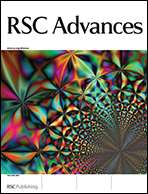Combined experimental and theoretical Raman scattering studies of α-quartz-type FePO4 and GaPO4 end members and Ga1−xFexPO4 solid solutions†
Abstract
α-Quartz-type Ga1−xFexPO4 solid solutions (0.04 ≤ x ≤ 0.28) and pure GaPO4 and FePO4 end members were studied by X-ray diffraction (XRD) and Raman spectroscopy to investigate the influence of iron content on the GaPO4 structure, and to have a better understanding of the lattice dynamics of the Ga1−xFexPO4 solid solutions. The unit cell parameters and structural distortion (i.e. inter-tetrahedral bridging θ, and tetrahedral tilt δ angles) of Ga1−xFexPO4 solid solutions were found to vary linearly with the iron content. Coupled and decoupled vibrational modes were identified using Raman spectroscopy and the calculation of the localization entropy using density functional theory. The GaPO4 decoupled modes are centered at 98, 237, 365 and 183 cm−1 and respectively assigned to E(TO1), E(TO5), E(TO7) and A1, while the vibrational modes located between 400 and 1200 cm−1 could be coupled. The coupled A1 bending mode centered at 457 cm−1 in pure α-GaPO4 was found to vary linearly as a function of iron content at room temperature. This mode could be therefore used to determine the iron content in Ga1−xFexPO4 solid solutions.


 Please wait while we load your content...
Please wait while we load your content...